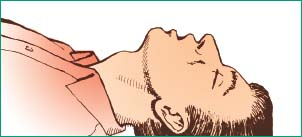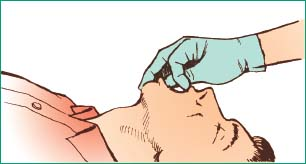Oropharyngeal Airway Insertion and Care
An oropharyngeal airway, a curved plastic device, is inserted into the mouth to the posterior pharynx to establish or maintain a patent airway. In an unconscious patient, the tongue usually obstructs the posterior pharynx. The oropharyngeal airway conforms to the curvature of the palate, removing the obstruction and allowing air to pass around and through the tube. It also facilitates oropharyngeal suctioning. The oropharyngeal airway is intended for short-term use, as in the postanesthesia or postictal stage. It may be left in place longer as an airway adjunct to prevent the orally intubated patient from biting the endotracheal tube.
The oropharyngeal airway isn’t the airway of choice for the patient with loose or avulsed teeth or who has undergone recent oral surgery.
Nursing Alert
Inserting this airway in the conscious or semiconscious patient may stimulate vomiting and laryngospasm; use only in unresponsive patients who don’t have a cough or gag reflex.1
Inserting an Oral Airway
Unless this position is contraindicated, hyperextend the patient’s head (as shown below) before using either the cross-finger or tongue blade insertion method.
 |
To insert an oral airway using the cross-finger method, place your thumb on the patient’s lower teeth and your index finger on his upper teeth. Gently open his mouth by pushing his teeth apart (as shown below).
 |
Insert the airway upside down to avoid pushing the tongue toward the pharynx, and slide it over the tongue toward the back of the mouth. Rotate the airway as it approaches the posterior wall of the pharynx so that it points downward (as shown below).
 |
To use the tongue blade technique, open the patient’s mouth and depress his tongue with the blade. Guide the airway over the back of the tongue as you did for the cross-finger technique.
Equipment
For Insertion
Oral airway of appropriate size ▪ tongue blade ▪ padded tongue blade ▪ gloves ▪ tape ▪ Optional: suction equipment, handheld resuscitation bag or oxygen-powered breathing device.
For Cleaning
Hydrogen peroxide ▪ water ▪ basin ▪ Optional: pipe cleaner.
For Reflex Testing
Cotton-tipped applicator.
Preparation of Equipment
Select an airway of appropriate size for your patient; an oversized airway can obstruct breathing by depressing the epiglottis into the laryngeal opening. Usually, you’ll select a medium size (size 4 or 5) for the average adult and a large size (size 6) for the large adult. Be sure to confirm the correct size of the airway by placing the airway flange beside the patient’s cheek, parallel to his front teeth. If the airway is the right size, the airway curve should reach to the angle of the jaw.
Implementation
Verify the doctor’s order.
Gather the appropriate equipment.
Confirm the patient’s identity using at least two patient identifiers according to your facility’s policy.2
Stay updated, free articles. Join our Telegram channel

Full access? Get Clinical Tree


Get Clinical Tree app for offline access
